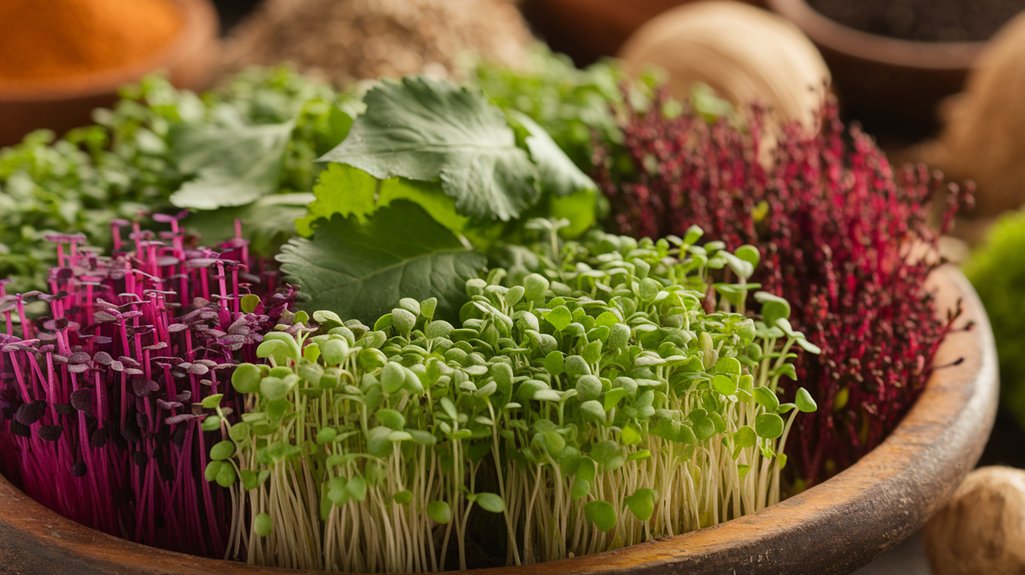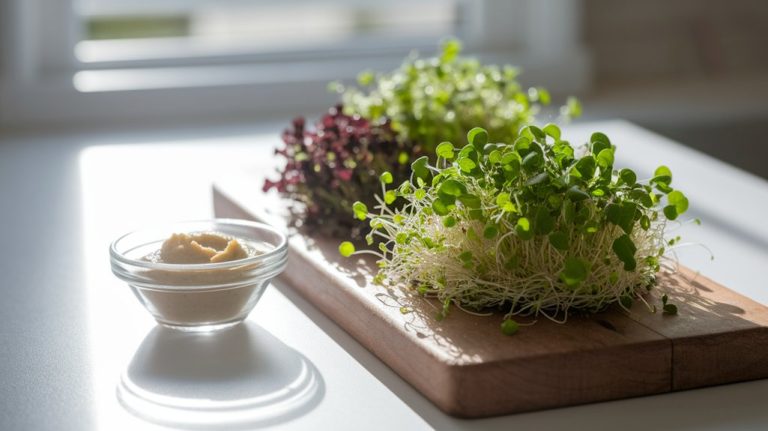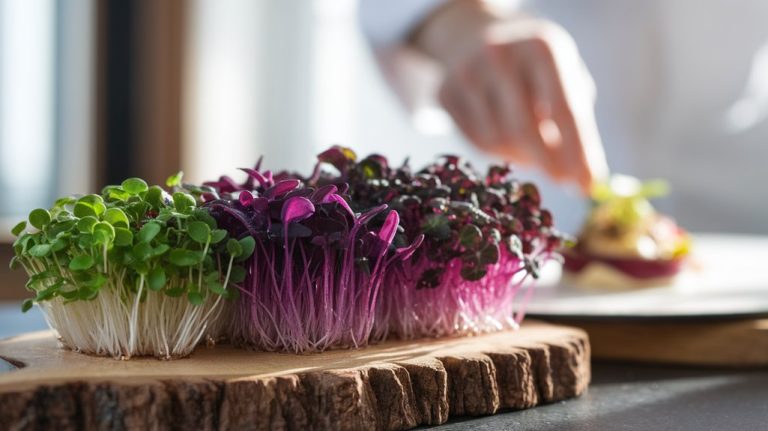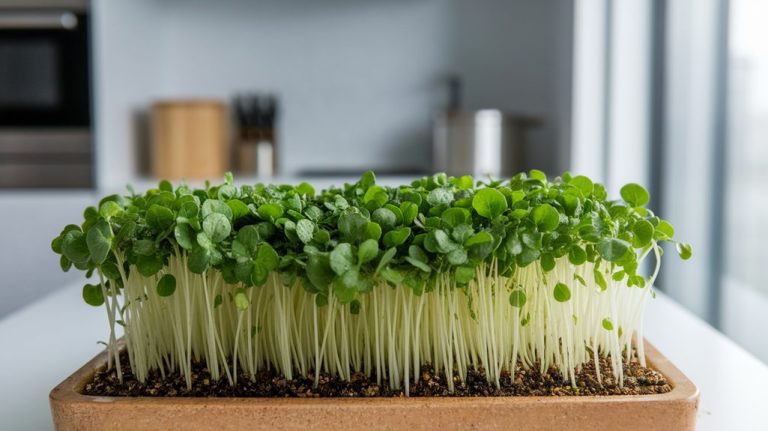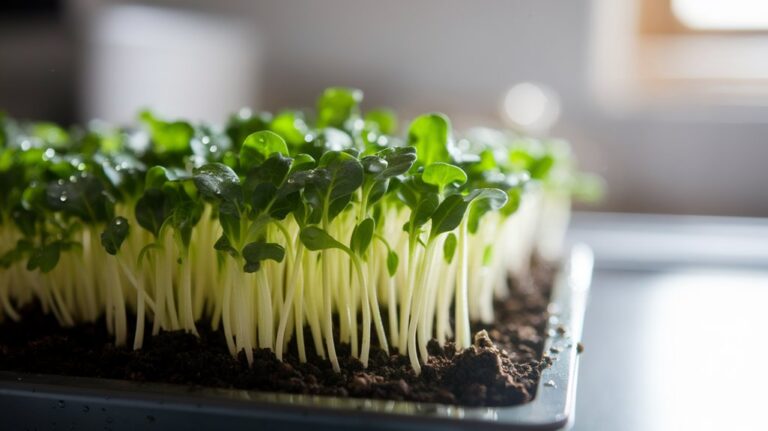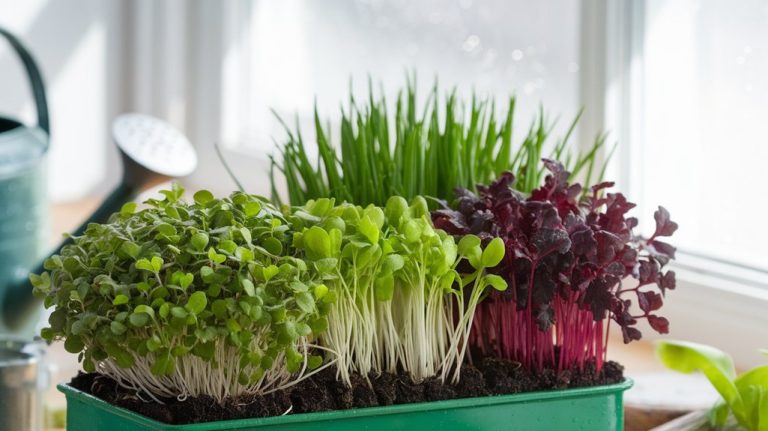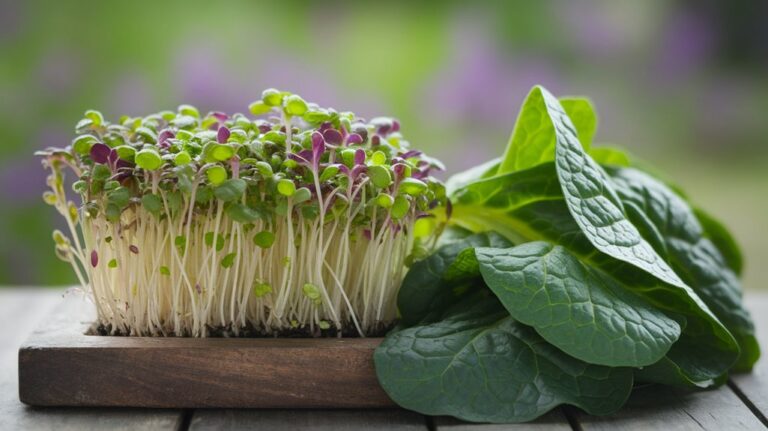Microgreens in World Cuisines: Global Flavors From Tiny Leaves
Microgreens are truly exciting! They bring vibrant flavors and nutrients to cuisines around the globe. In Asian dishes, shiso and mustard microgreens enhance textures, while arugula and chervil elevate European salads and sauces. Latin American meals burst with the freshness of radish and cilantro microgreens. They’ve become culinary game-changers, turning simple meals into artistic delights. Curious about how to incorporate these tiny leaves into your own cooking adventures? There’s so much more to explore!
Key Takeaways
- Microgreens like shiso and mustard enhance traditional Asian dishes with unique flavors and textures, adding freshness to sushi and balancing sweetness in stir-fries.
- In European cuisine, arugula and chervil microgreens elevate dishes such as caprese salad and béarnaise sauce, blending tradition with modern flair.
- Latin American recipes benefit from microgreens, with radish and cilantro adding vibrant color, flavor, and nutritional value to guacamole and black bean soup.
- Microgreens provide chefs with a versatile ingredient, allowing for creative presentations and innovative combinations across various global cuisines.
- The use of microgreens reflects a growing trend towards health-conscious dining, enhancing meals with concentrated nutrients while promoting sustainability in culinary practices.
The Rise of Microgreens in Culinary Arts
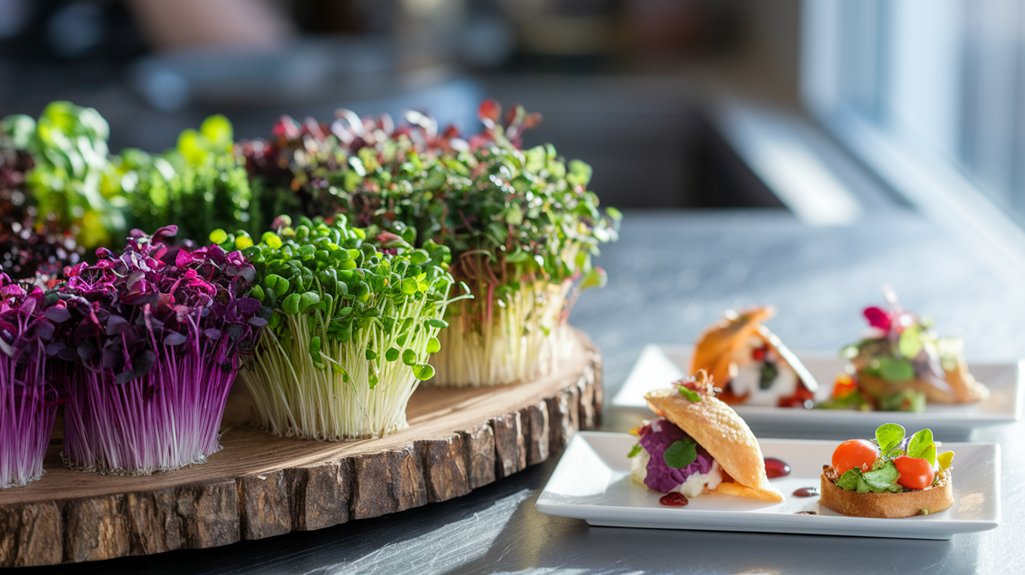
As I explore the culinary landscape, I can’t help but notice how microgreens have surged in popularity, transforming the way we think about flavor and presentation.
These tiny, vibrant greens pack an impressive punch, elevating dishes with their concentrated taste and striking colors. From delicate pea shoots to zesty radish greens, each variety adds a unique element to both taste and visual appeal.
I’ve seen chefs sprinkle them atop gourmet plates, turning simple meals into works of art. What’s more, their nutritional benefits are remarkable; they’re often richer in vitamins than their mature counterparts.
As we embrace this trend, I’m excited to see how microgreens will continue to inspire culinary creativity across world cuisines, making every bite a delightful experience.
Asian Influences: Spicy and Sweet
The vibrant world of microgreens finds a particularly exciting expression in Asian cuisines, where flavors often dance between spicy and sweet.
I love how these tiny greens, like shiso and mustard, add a punch of flavor to dishes. For instance, shiso microgreens bring a unique, aromatic twist to sushi rolls, balancing the umami of fish with their refreshing taste.
Meanwhile, the slightly bitter taste of radish microgreens complements the sweetness of stir-fried vegetables beautifully.
I’ve even experimented by tossing them into spicy Thai salads, where they soften the heat while enhancing the overall texture.
Each bite becomes a mini explosion of flavor, showcasing how microgreens can elevate traditional recipes, bringing a fresh, modern twist to beloved classics.
European Delights: From Salads to Garnishes
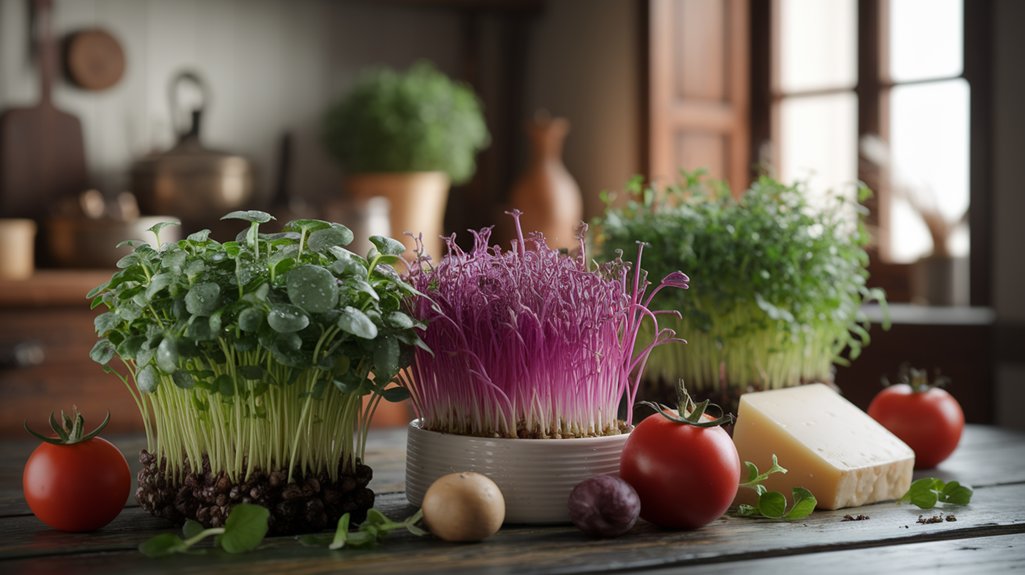
While exploring the culinary landscape of Europe, I’ve discovered that microgreens play a pivotal role in transforming simple dishes into extraordinary experiences.
From the vibrant arugula microgreens peppering a classic Italian caprese salad to the delicate chervil enhancing a French béarnaise sauce, these tiny leaves pack a flavor punch. I love how they add a fresh crunch and a burst of color to dishes, making them visually appealing.
In Scandinavian cuisine, I’ve found dill microgreens elevate pickled herring to new heights. I’ve also seen them used as garnishes in Polish soups, adding depth and aroma.
Each region showcases unique microgreens, and it’s fascinating how these little greens can define a dish, bridging tradition with modern flair.
Latin American Flavors: A Fresh Twist
When you dive into Latin American cuisine, you’ll quickly realize that microgreens offer a vibrant twist to beloved dishes. These tiny leaves, bursting with flavor, elevate traditional favorites like tacos and ceviche.
Imagine topping your freshly made guacamole with zesty radish microgreens, adding a peppery crunch that dances on your palate. Or consider a colorful garnish of cilantro microgreens on a rich black bean soup, enhancing both aroma and taste.
They’re not just pretty; they pack a nutritional punch too! From peppery mustard greens to sweet basil sprouts, these microgreens bring freshness and complexity to every bite.
Middle Eastern Cuisine: Aromatic and Bold
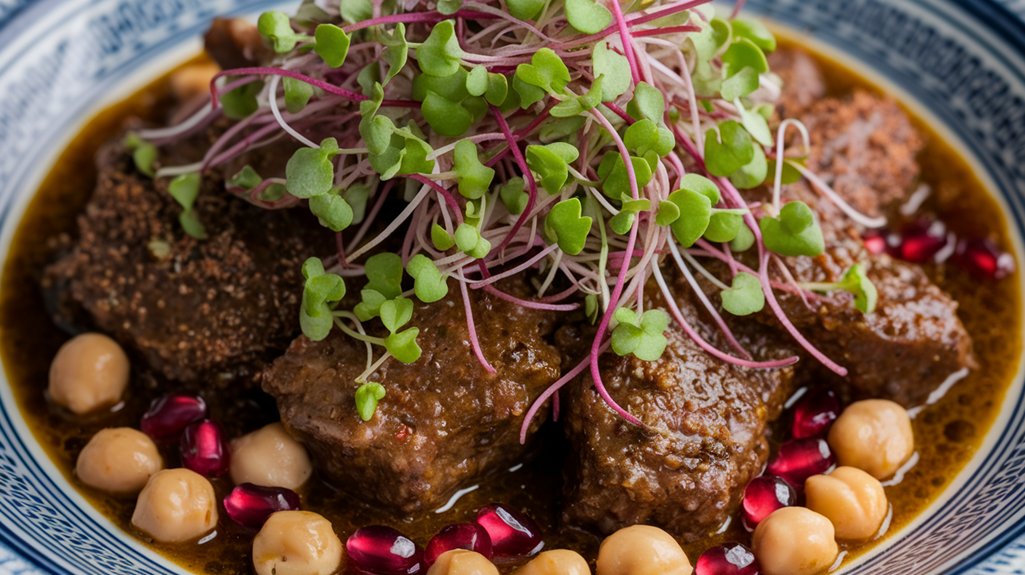
Exploring Middle Eastern cuisine reveals a world rich in aromatic spices and bold flavors, where microgreens play an essential role in elevating each dish.
Take za’atar, a fragrant blend of herbs and spices; adding fresh microgreens like arugula or mustard greens brings a peppery crunch that perfectly complements its earthiness.
I love incorporating micro basil into a classic tabbouleh, enhancing the dish’s freshness while adding a pop of color.
Then there’s the explosion of flavors in a shawarma wrap, where micro cilantro adds a zesty finish.
Each tiny leaf contributes not just taste, but texture and visual appeal, transforming traditional recipes into vibrant culinary experiences.
The versatility of microgreens truly shines in this aromatic and bold cuisine.
Incorporating Microgreens Into Everyday Cooking
Microgreens can effortlessly elevate even the simplest meals, transforming everyday cooking into something extraordinary. I love tossing a handful of vibrant microgreens into my salads, sandwiches, and even soups. Their burst of flavor adds a delightful twist that’s hard to resist.
Here’s a quick guide on how I incorporate them:
| Dish Type | Microgreens Used | Flavor Profile |
|---|---|---|
| Salad | Arugula microgreens | Peppery and fresh |
| Sandwich | Radish microgreens | Spicy and crunchy |
| Soup | Pea shoots | Sweet and tender |
| Omelet | Basil microgreens | Aromatic and herbal |
With just a sprinkle of these tiny leaves, I create a culinary masterpiece that not only looks stunning but tastes incredible. Give it a try!
Nutritional Benefits of Microgreens
After enjoying the vibrant flavors microgreens bring to my dishes, I can’t help but appreciate their impressive nutritional profile.
These tiny leaves pack a powerful punch, offering a host of health benefits that elevate any meal. Here are three key advantages I’ve discovered:
- High Nutrient Density: Microgreens contain concentrated vitamins and minerals, often surpassing their mature counterparts.
- Antioxidant Richness: They’re loaded with antioxidants, which help combat oxidative stress and promote overall health.
- Digestive Support: Their fiber content aids digestion, making them a great addition to any diet.
Incorporating microgreens into my meals not only enhances flavor but also boosts my nutritional intake.
It’s an effortless way to nourish my body while enjoying culinary creativity!
Growing Microgreens at Home
Growing microgreens at home is simpler than I ever imagined, and it’s incredibly rewarding.
With just a few easy techniques and the right environment, anyone can cultivate these nutritious little greens in their kitchen.
Let’s explore how to create the ideal conditions for a thriving microgreen garden right in your own space!
Easy Growing Techniques
While it might seem daunting to cultivate your own microgreens at home, I assure you that with a bit of patience and the right techniques, it’s an incredibly rewarding endeavor.
Here’s how I get started:
- Select Your Seeds: Choose varieties like arugula, radish, or basil that germinate quickly and are packed with flavor.
- Prepare Your Containers: Use shallow trays with drainage holes. Fill them with a quality potting mix, leveling it off gently.
- Water Wisely: Mist the soil to moisten it without soaking, then cover the tray with a lid or plastic wrap until seeds sprout.
In just a week or two, you’ll have vibrant greens ready to elevate your dishes with fresh, zesty flavors!
Ideal Growing Conditions
Creating a thriving microgreens garden at home requires the right environment to ensure those tiny greens flourish.
I’ve learned that light is crucial; placing my trays near a sunny window or using grow lights keeps them vibrant and healthy. Temperature matters too—most microgreens thrive between 65°F and 75°F.
I always keep the soil moist but not soggy, as overwatering can lead to mold. Good air circulation is essential, so I avoid overcrowding my trays.
If I notice any pests, I act fast, using natural remedies to protect my greens. By paying attention to these conditions, I’ve successfully cultivated an array of microgreens, bringing fresh flavors right into my kitchen for salads, sandwiches, and garnishes.
Happy growing!
The Future of Microgreens in Global Cuisine
As we explore the vibrant world of global cuisine, it’s impossible to overlook the rising prominence of microgreens. These tiny leaves aren’t just a garnish; they’re transforming how we experience flavor and nutrition.
I believe the future of microgreens holds exciting possibilities:
- Culinary Innovation: Chefs are incorporating microgreens into traditional dishes, elevating flavors and aesthetics.
- Health Trends: As more people seek nutritious options, microgreens offer concentrated vitamins and minerals, appealing to health-conscious diners.
- Sustainable Practices: Their quick growth and minimal space requirements make them ideal for urban farming, promoting local and sustainable food sources.
Embracing microgreens in various cuisines can create a delightful fusion of taste and health.
I can’t wait to see where this journey takes us!
Frequently Asked Questions
What Are the Most Popular Microgreens Used Worldwide?
When I think about the most popular microgreens used worldwide, I can’t help but mention arugula, with its peppery kick.
Then there’s radish microgreens, bursting with flavor. I also adore basil microgreens for their aromatic freshness.
Sunflower and pea shoots are favorites, too, adding crunch and sweetness to dishes.
These tiny greens not only elevate meals but also pack a punch of nutrients, making them a staple in kitchens everywhere I go.
How Do Microgreens Vary in Flavor Profiles?
Microgreens offer a delightful range of flavor profiles that truly excite my palate. For instance, basil microgreens burst with sweet, aromatic notes, while radish microgreens pack a spicy punch.
I love how cilantro microgreens deliver that fresh, citrusy zest, making dishes come alive. Each tiny leaf adds its unique twist, enhancing everything from salads to sandwiches.
Exploring these diverse flavors has become one of my favorite culinary adventures, and I can’t get enough!
Can Microgreens Be Grown Indoors Year-Round?
Absolutely, I can grow microgreens indoors year-round! It’s a fun and rewarding experience.
I use shallow trays filled with soil, ensuring they get enough light—either from a sunny window or grow lights.
I’ve noticed that different varieties thrive best under specific conditions, so experimenting is key.
With regular watering and attention, I harvest fresh, vibrant greens throughout the seasons, adding flavor and nutrition to my meals no matter the weather outside!
Are There Any Allergies Associated With Microgreens?
I’ve wondered about allergies related to microgreens, and it turns out they can trigger reactions in some people.
Common allergens include arugula and mustard greens, which belong to the Brassica family. If you’re sensitive to certain plants, it’s wise to be cautious.
I always recommend starting with small amounts to see how your body reacts.
It’s fascinating how these tiny greens can pack such big flavors and potential allergens!
What Are the Best Storage Methods for Fresh Microgreens?
When it comes to storing fresh microgreens, I’ve found that keeping them in a breathable container works wonders.
I usually place them in a damp paper towel, then tuck them inside a perforated bag or a container with holes. This method keeps them fresh for about a week.
I also avoid washing them until I’m ready to use them, as excess moisture can lead to spoilage.
Trust me, this keeps them vibrant and delicious!
Conclusion
As I’ve explored the vibrant world of microgreens, it’s clear these tiny leaves pack a punch in flavor and nutrition across global cuisines. Whether you’re spicing up an Asian dish or adding a fresh twist to a Latin American favorite, microgreens elevate every meal. Their versatility invites creativity in our kitchens, making it easier than ever to embrace healthy eating. So why not start growing your own? The future of culinary adventures with microgreens is just a seed away!

